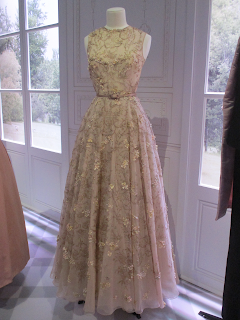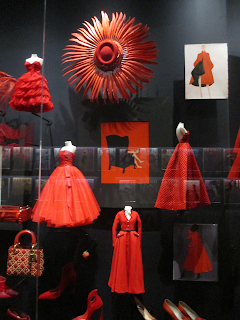"I think of my work as ephemeral architecture, dedicated to the beauty of the female body." Christian Dior, 1957
I missed the opportunity to see this show on its debut in Paris two years ago at the Musée des Arts Décoratifs as the queues were huge, and rather than waste precious time whilst in the French capital queueing, I decided to go to a favourite brasserie instead for a carafe of wine before catching the Eurostar home. I am so pleased that Christian Dior: Designer of Dreams has come to London though, as it is a fabulous opportunity to see at close quarters the amazing work of the designers and artisans that goes into creating couture garments. In this respect the show is a fantasy, and the various heads of design at Dior have designed the most fantastical of dresses. It contains the kind of fairytale gowns that most women (and the odd transvestite), can only dream of, and aspire to, because they are affordable only to the very wealthy.
This show, as befits a major fashion house is beautifully and immaculately presented with the dresses shown off in a series of spectacular tableaux to reflect both the drama and vision of the history of Dior, and the concepts of the individual designers. I doubt you will see a better presented or extravagant exhibition this year. Christian Dior: Designer of Dreams is a blockbuster exhibition, and a juggernaut which currently threatens to leave attendance figures for all other V&A exhibitions trailing in its wake. I feel a new series of Scissorhands dress pieces coming on!
The New Look
The exhibition opens with a room designed to look like the façade of Dior's flagship store on Avenue Montaigne in Paris, the centrepiece of which is Dior's original iconic Bar suit, and the subsequent Dior head designers take on that particular outfit. Christian Dior was born into a wealthy Normandy family in 1905, and from an early age enjoyed gardening, looking at architecture and designing costumes for his friends. In 1946 Dior secured financial backing and opened his own couture house. Dior presented his first haute couture collection on 12th February 1947, to much anticipation. The collection offered a radical, more feminine alternative to the more boxy, masculine post-war fashions for women. The term 'new look' was coined by the then editor of Harper's Bazaar, Carmel Snow, and was subsequently adopted as the name for the collection, which featured full skirts and nipped in waists with shaped hips and full busts. This 'New Look' using yards of fabric in a post-war age of austerity was thought to be shockingly frivolous at a time when women were encouraged to "make do and mend" with ration books.
This outfit by Dior can be found upstairs in the V&A's Theatre and Performance galleries. It is a costume for the character of Paola, played by actress Vivien Leigh in the 1958 play Duel of Angels. It is designed in the style of Dior's New Look although the play is set in the 19th century. You can see that in comparison with the Bar Suit above, that the tightly fitted jacket emphasising the waist and voluminous skirt are all hallmarks of Dior's New Look style.
This outfit by Dior can be found upstairs in the V&A's Theatre and Performance galleries. It is a costume for the character of Paola, played by actress Vivien Leigh in the 1958 play Duel of Angels. It is designed in the style of Dior's New Look although the play is set in the 19th century. You can see that in comparison with the Bar Suit above, that the tightly fitted jacket emphasising the waist and voluminous skirt are all hallmarks of Dior's New Look style.
More New Look styling below.
Dior in Britain
" I adore the English, dressed not only in the tweeds which suit them so well, but also in those flowing dresses, in subtle colours, which they have worn inimitably since the days of Gainsborough." Christian Dior, 1957
Christian Dior was an avid Anglophile who liked the sense of freedom experienced in Britain. Dior was delighted to be invited to create the dress for Princess Margaret's 21st birthday, and those of other debutantes for society balls. His initial show in Britain was at the Savoy Hotel in 1950, and then in grand country houses like Blenheim Palace. Dior further established himself on these shores by establishing C D models - a ready-to-wear branch of his haute couture lines sold in establishments such as Harrod's and Kendall Milne in Manchester.
Princess Margaret's 21st birthday gown.
Historicism
"I thank heaven I lived in Paris in the last years of the Belle Époque" Christian Dior, 1957
"I thank heaven I lived in Paris in the last years of the Belle Époque" Christian Dior, 1957
Dior mined certain historical periods to create his designs - a practice which has become standard across all art/design disciplines, and this section of the exhibition is a recreation of the temple de l'Amour in Versailles. Dior had a particular penchant for the 18th century, and the style of this period and that of the palace of Versailles pervaded the décor of his design studio and personal apartment, as well as the dresses he designed. This period was also influential to successive designers of the House of Dior.
Travels
Christian Dior enjoyed travel and took inspiration from the art, architecture and textiles of the many places that he visited, even naming certain dresses after the places that inspired their creation. This gallery focused on the way in which designers that followed Dior have interpreted the designs of foreign cultures amid accusations of appropriation.
The Garden
"After women, flowers are the most divine of creations." - Christian Dior, 1954
Flowers
were a constant source of inspiration for Dior in both his clothing
designs and his perfume ranges. His New Look was inspired by the
shape of an inverted flower. The successive designers for Dior also took
flowers as a basis for their designs. This room in the exhibition was
stunning with a profusion of lilac flowers cascading from the ceiling.
Designers
After the beauty of the Garden the next space is dedicated to the designers who have been charged with retaining the legacy of the House of Dior.
First up was Yves Saint Laurent, appointed design director at the tender age of 2 in 1957, who modernised the label with the silhouette of his successful Trapèze line.
The next dcreative director was the longest serving - Marc Bohan from 1960-89. Bohan became famed for his Dior Slim look collection, and his quote - 'N'oubliez pas la femme' (Don't forget the woman).
Gianfranco Ferré was the next creative director to take the helm at Dior from 1989-96, and was awarded the coveted Dé d'or (Gold Thimble) for haute couture.
John Galliano succeeded Ferré as the creative head from 1996-2011, and is renowned for his eclectic, dramatic and theatrical designs. Although he left the label under somewhat of a cloud, his designs stand out as some of the strongest in the show.
Raf Simons' tenure at the head of Dior design was fairly brief - from 2012-15. Simons concentrated on cut and line with a practicality for the modern woman.
And lastly but by no means least, we come to current head and sole female lead creative of the House of Dior to date - Marie Grazia Chiuri - 2016 - present. With a feminist agenda drawing inspiration from women of note in history Chiuri creates covetable pieces such as that leather beret, and dreamily feminine ballgowns.
The Ateliers
"Everything created by human hands expresses something - above all the personality of the creator. The same thing is true with a dress. But since so many people are working on it, the real job is to get all the hands that cut, sew, try on and embroider to express all I have felt." - Christian Dior, 1954
A collection of prototype Dior toiles - a tribute to the 'petite mains' - the real (s)heroes of haute couture - whose magically nimble fingers and hours of work are so essential in creating and bringing to life the haute couture visions of the lead creatives. The virgin-white calm, and starkness of this gallery made it one of the strongest. You can see more on the artisanal houses and petite mains here.
Diorama
This gallery space is dedicated to the accessories designers who have worked with the fashion house to complete the Dior look. They include the creations of bottles from perfumiers, miniature versions of Dior haute couture, shoes by Roger Vivier, hats by Stephen Jones and the work of illustrator René Gruau etc. and also on the wall opposite magazines who have featured Dior designs on their covers.
The darkness of the space contrasted with the vivid spectrum colours of the clothes and accessories in the Diorama gallery were a jolt to the senses after the blinding white purity of the toiles. The shoes were sculptural and absolutely insane!
The Ballroom is the culmination of the exhibition, and the section in which the designers let their imaginations run riot indulging their fantasies to create the most covetable couture. The fairytale setting of this room in which shooting stars and glittering rain sparkle across the planetarium-style ceiling, reflects the high octane glamour of the dresses. Absolutely gorgeous!
Christian Dior: Designer of Dreams
until 1st September
Victoria and Albert Museum
Cromwell Road
London














































































































